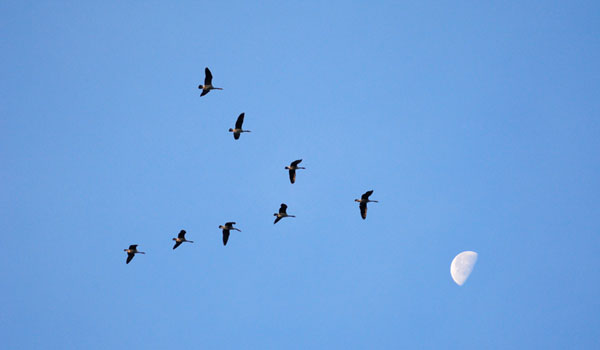
Why Do Bird Flocks Move in Unison?

Every autumn, flocks of birds begin to migrate to warmer territories. But how do they stay in such perfect formation?
The impressive, perfectly timed flight maneuvers of bird flocks, as well as their symmetrical group formation, can be summed up in a simple model, according to researchers from Budapest, Hungary.
The model determined that birds collectively switch from a flying state to a landing one, during which group action overrides the individual landing intentions of each bird, according to the study, published in the September issue of the New Journal of Physics.
While not all birds migrate, those that do usually head south how far south depends on the particular species, according to the Smithsonian National Zoological Park. Scientists have long tried to pin down the reason behind the timing of birds' migratory behavior, with theories suggesting birds' preference of eating fruit could drive the migration, or perhaps a requirement for non-forested environments.
Seasonal food scarcity is a more likely reason, according to ecologists at the University of Arizona in Tucson. After studying 379 species of migratory birds, the researchers determined that the number-one predictor that a species was about to migrate was a lack of food. The findings are detailed in the March 2007 issue of American Naturalist.
"If you are faced with food scarcity, you have two options," said W. Alice Boyle, an adjunct lecturer in UA's department of ecology and co-author of the study, in a statement. "You can either forage with other birds, or you can migrate."
While migrating bird flocks can be spotted during the daytime, most birds migrate at night (when the air is cooler and calmer, and there are fewer predators), flying in tandem even when they are 655 feet (200 meters) or more apart, according to a University of Illinois study published in the July 2008 issue of the journal Integrative and Comparative Biology.
Sign up for the Live Science daily newsletter now
Get the world’s most fascinating discoveries delivered straight to your inbox.
Some birds, including swans, geese, cranes, pelicans and flamingos, form tight, V-shaped patterns, while others fly together in loose flocks. V-shaped formations help birds conserve energy, since each bird flies slightly ahead of the other, there is less wind resistance. To keep things fair, birds take turns being in the front, with each bird moving to the back when they get tired, according to the National Park Service.
Age, sex and body size also play a role in who leads the V-formation. In a flock of adults and young birds, juveniles usually do not lead since they are less able to maintain high speeds in lead position and would slow the entire flock down, according to a study by Swedish researchers published in the January 2004 issue of the journal Behavioral Ecology.
The researchers also determined that pelicans that fly in group formation beat their wings less often and have lower heart rates than those that fly alone. In this way, birds that fly in V-formation conserve much-needed energy during their long, difficult journeys.
This V-formation also enhances communication and coordination within the flock, allowing birds to improve orientation and follow their route more directly. In formation, every bird is accounted for, according to the Swedish study.
Got a question? Email it to Life's Little Mysteries and we'll try to answer it. Due to the volume of questions, we unfortunately can't reply individually, but we will publish answers to the most intriguing questions, so check back soon.










